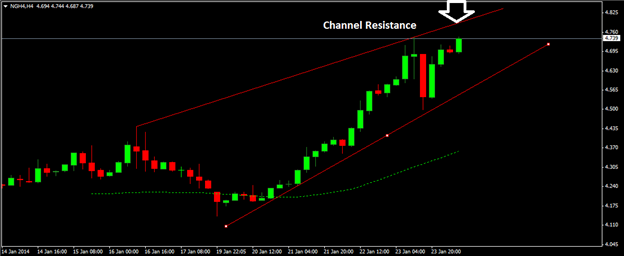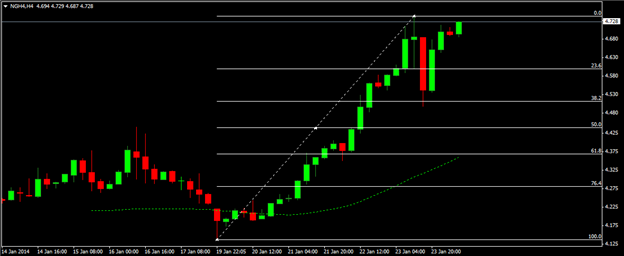Main Points
- Temperatures in the eastern parts of US likely to remain well below normal till 1st Feb
- More surge in price expected as demand and supply gap widens
- Resistance seen at $4.91
- RSI enters oversold territory that means correction might be in play before further rallies
Natural Gas futures for February delivery surged to $4.74 per Million British Thermal Unit (MBTU) on Thursday, the highest level since June 2011, after weather experts predicted sustained cold spell till the end of current month.
At the moment of writing in London session gas is being traded at $4.71 with immediate resistance seen around $4.74, yesterday high, ahead of $4.79, current channel resistance. A break above this level may push price into stronger bullish momentum thus targeting $4.91, 161% retracement.

On downside, support is seen around $4.60 ahead of $4.51 that are two important fib retracement levels. In addition to these levels, price may also find support around channel support as shown in above chart. As per swing analysis price may come down as low as $4.51 in correction phase unless we see more upside movement above yesterday’s high.

It is however pertinent that Relative Strength Index (RSI) is showing oversold readings which means we may see a dip in gas price before further spikes. No divergence is noted that suggests sound presence of buyers.
The ongoing upward move in gas price is mainly due to heavy snowfall and record low temperatures that significantly lifted the demand for gas. Gas inventories sunk to 107 billion cubic ft at the end of last week, a government report revealed yesterday and showed current inventory at 2.423 trillion. Previously analysts had predicted 103 billion cubic ft fall in gas inventories.
Weather is likely to remain much colder than normal throughout eastern parts of the US till 1st February, Commodity Weather Group based in Bethesda said on Thursday. 48 lower states of the US may witness the coldest winter since 1990 this year, the group revealed in a report.
AccuWeather Inc. predicted minimum -13 degrees Fahrenheit temperature on January 27 in Chicago that is much lesser than normal. In a separate report EIA predicted minimum 12 degrees Fahrenheit temperature on January 27 in New York which is 15 degrees below the normal temperature in January.
In addition weaker dollar also fueled the bullish momentum in Gas yesterday after labor department data showed that number of people who filed claims for unemployment rose at the end of last week. Jobless claims data was worse than expectations that consequently trigger a sharp downside trend in the US Dollar Index.
Later this month a very important Federal Open Market Committee (FOMC) meeting is going to be held in which policymakers may announce reduction in monthly asset-buying program by $10 billion according to average projection of many analysts. Federal Reserve had already reduced stimulus by $10 billion in monetary policy meeting held in December, more trimming in bond purchases will strengthen dollar and in turn may put pressure in gas price.
original source

 By
By 

















